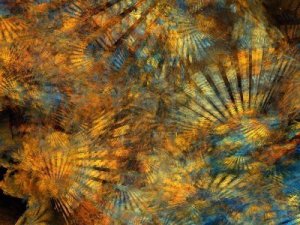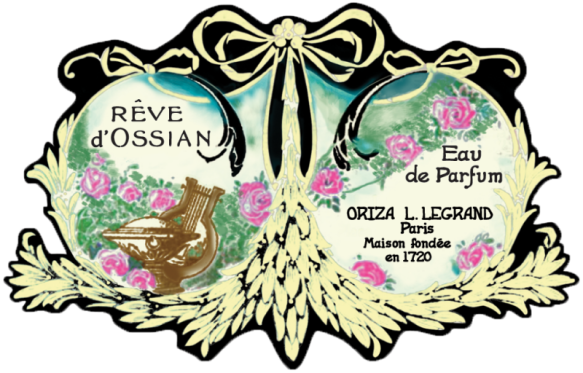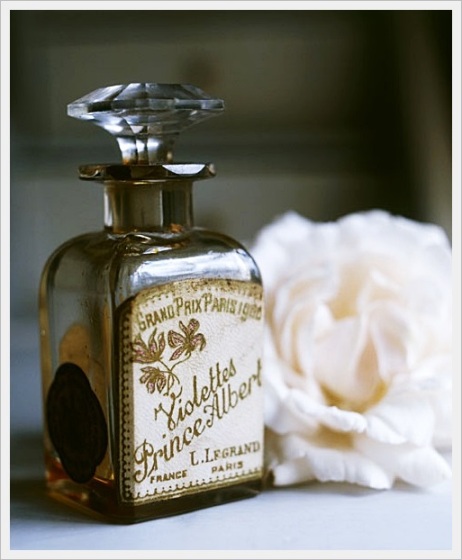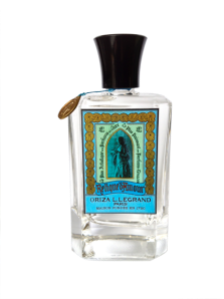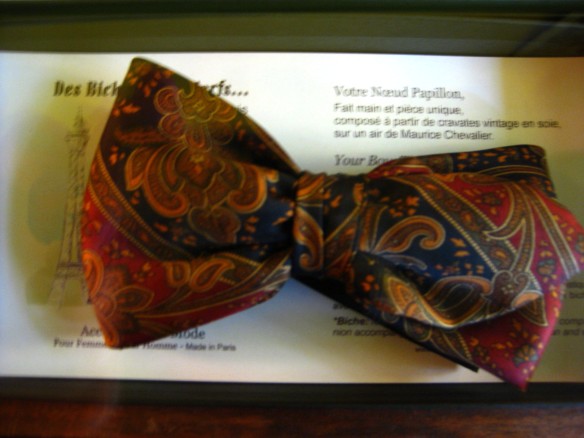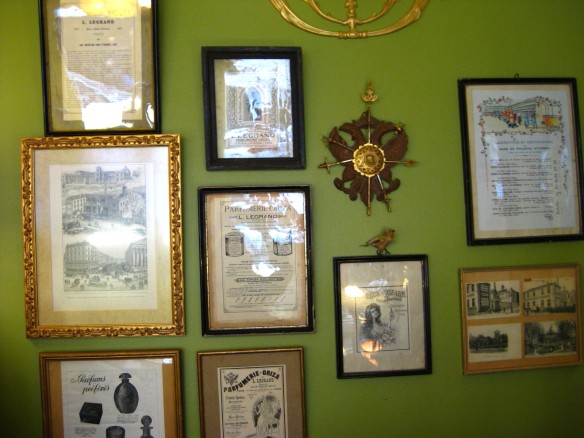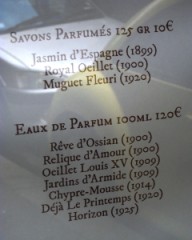An ancient perfume house whose fragrances have been brought back to life like Sleeping Beauty awakened with a kiss. Oriza L. Legrand (hereinafter just “Oriza”) is not a well-known house, but its perfumes have a unique character that is redolent of the past and the classic French tradition. Yesterday, I provided an overview of the brand, its history and how its fragrances have been tweaked from the 1900s to suit today’s tastes. Today, I’d like to briefly review three Oriza perfumes: Chypre Mousse, Horizon, and Reve d’Ossian. The remaining four, primarily floral fragrances — Relique d’Amour, Jardins d’Armide, Oeillet Louis XV, and Deja Le Printemps — are the focus of another post.
Oriza describes Chypre Mousse (at the link imbedded above in the title) as the essence of nature in autumnal woods:
After the first rainfall in September nature exude scents of humus, peat and wetland. [¶] This is the time for a promenade in the woods to enjoy the freshness after the heat of summer. [¶] Autumn encourages us to contemplate, to observate nature that gently prepares us for the coming winter and its frostbite.
The mossy paths, precious jewels of the undergrowth, are brightened by the last rays of sun. [¶] Cyprus-Moss evokes in us our surrounding nature which soon will be covered by the first fall of snow. [¶] Smell of damp undergrowth of scorched leaves and the scent of moss before picking mushrooms and chestnuts.
Chypre-Mousse, a Fragrance of the House Oriza L. Legrand launched in 1914 for the dandies of this world!
Top Notes[:] tonic & balsamic: Wild mint, clary sage, wild fennel & green shoots.
Heart notes[:] aromatic & flowing properties: Oakmoss, Galbanum, Angelica, fern, wild clover, Mastic & Violet leaves.
Backgrounds[:] Notes mossy & leathery: Vetiver, Pine Needles, Oak Moss, Mushroom fresh Humus, Roasted Chestnut Leather, labdanum & Balms.
As outlined in my earlier post on Oriza, I went to the boutique with the goal of sniffing and possibly buying a very different perfume, Horizon. I’m generally not one who buys a perfume without testing, especially given my crazy skin and how voracious it is. So, I sprayed both fragrances on my skin and on the sweater that I was wearing, walked out of the store to think about it, and headed on my way to Serge Lutens to buy my precious bell-jar. I went four blocks, sniffing myself throughout, then stopped dead in my tracks, and headed back. I had to have Chypre Mousse, then and there, without further testing. Suffice it to say, that is extremely unusual for me.
I’m not sure how to best describe Chypre Mousse. It’s not the typical oakmoss fragrance; it has neither the dark grey, mineralized, dusty fustiness of some oakmoss fragrances, nor the bright green, softly plush, fresh mossy feel of others. To me, it smells like the damp forest floor, wet leaves, dewy violets, earthy mushrooms, drenched forests, and a symphony of green, brown, grey, and purple. Again and again, I go back to Oriza’s description of “green shoots,” because there is something of youthful life that is pushing through the wet floor of a verdant forest.
Chypre Mousse opens with a pungent but sweet oakmoss that feels as though it’s sprouted right off the bark of a tree deluged by rain. There is a dark leather underlying it, covered in resinous, piney tree sap, swirled with darkened mosses, and speckled with reddish mushrooms. The strip of leather lies atop a mound of leaves whose autumnal oranges and browns have turned darker with dampness and water. All around are bunches of fresh violets, pushing out through the soil, past the green shoots, and in the wet space left untouched by the gnarled, woody roots of surrounding pine trees. The dewy, sweet purple flowers form a bright spot of colour in the dark, green forest.
The leather, wood, mushrooms, wet leaves, violets, grass, and moss are backed by traces of other notes. The sweetest black earth, the freshest of green herbs, the stoniest of grey boulders, the darkest of tree sap, and just the subtlest hint of smoky incense. The forest has come alive in a symphony that is leafy, earthy, green, woody version of Serge Lutens‘ delicate floral masterpiece, De Profundis. There is the same sort of haunting delicacy, of dewy wetness, of youthful life. The two perfumes are fundamentally different in notes, but they share a very similar feel. And, oddly, there is something of a chrysanthemum undertone in Chypre Mousse. Perhaps it’s the slightly piquant, peppered, floral greenness created by the other accords together that creates that strange impression. Whatever the cause, Chypre Mousse has the same haunting, evocative impact on me.
The most interesting aspect of Chypre Mousse may be the more unexpected notes. I have no idea what the “hummus” reference in Oriza’s list means, but the mushroom-y touch is fascinating. So is the combination of that leather note which has somehow been transformed by the other elements into something familiar, and yet not. This is leather that has been left out in the rain to have Nature and the forest absorb it, transforming it into something that is more a part of their world.
Yet, what I consistently found myself thinking about were the violets or pansies, whose tender refrain wraps its ribbons around you. The funny thing is, I never knew Chypre Mousse included them in my four or five early wearings, and I thought I was quite mad for detecting their delicate, purple hues in a scent intended to be a mossy, mushroom, earthy, forest one. In fact, long before I actually looked at Oriza’s list of notes, I sprayed Chypre Mousse on four people, and asked if they could detect violets. They merely scrunched up their eyes, responding with some form of dubious: “I guess.”
For them, Chypre Mousse was something indescribable, inexplicable, odd, but utterly mesmerizing. A swirl of unusual notes in a well-blended, seamless, elegant bouquet that they couldn’t place or categorize. One Paris fashionista who tested it took a single sniff of her arm, and immediately said, “I’ve never smelled anything like it. Where can I buy it?!” She couldn’t describe it, and neither could two others. A fourth tester was an experienced perfumista, and just looked at me with bewilderment. “What is this??!” Her initial response was uncertainty, but every passing minute changed that. She loved how she couldn’t put her finger on the scent or what lay underneath it. Even more so, she was astounded by the trails of aroma that followed in the air around her. As someone whose skin squashes both projection and longevity, she couldn’t get over it.
That brings me to Chypre Mousse’s sillage and longevity. It’s outstanding, even on my crazy, perfume-consuming skin. Two small sprays will create a large cloud all around me for the first hour, followed later by projection that extends about six inches. Later, when the sillage drops around the end of the third hour, Chypre Mousse continues to send out ribbons of scent in the air around you. And it lasts for ages. On average, I get around 10 hours with two small sprays, and well over 12 hours with more.
There are no entries for Chypre Mousse on Fragrantica thus far, but Ida Meister wrote a piece entitled Fragrant Snippets on a few of the Oriza scents. Like me, she was knocked off her feet by Chypre Mousse, and ordered a bottle right away. Her summation for the scent reads as follows:
It is Confession Time. I didn’t want to wait for another week: I ordered this edp PRONTO. 😉
Chypre-Mousse sings to me. All that lurks in the forest, humid and expectant after the first September rains. The exquisite aromas of the undergrowth; peat, mushrooms, humus. Moss and more moss; sheer delight for me, who craves that velvety green aromatic cushion beneath the nose, the feet, my fingers! A carpet of russet leaves underfoot, the seductive aroma of grilled chestnuts around the corner. Oriza may have had dandies in mind for Chypre-Mousse, but it is my ongoing intoxicating love affair with all things Green. I will wear my velvet cloak of chypre gratefully.
Chypre Mousse sings to me as well. I think it is an absolute masterpiece. To me, it doesn’t smell old-fashioned or dated for one simple reason: I’ve never smelled anything quite like it. From any age.
Horizon was originally released in 1925, and Oriza describes the fragrance as the embodiment of its decade:
After World War I, the Roaring Twenties reflect the desire of the exotic and the need also through fashion and decoration. [¶] The East and particularly Asia, provide new HORIZONS. [¶] The frenzy for exotic travel and encourages artists to transcend the culture of the East in their creations: new silk, fine embroidery, pearl beads, woody scents, heady and sweet …
In the euphoria of the Roaring Twenties, the female body is revealed, it abolished the corset, the flappers open the eyes and smoking languidly.
Slumming it in the salons of Paris!
The materials, colors, shapes symbolize a new freedom and portend, at the dawn of the Roaring Twenties, the hope of a new HORIZON. [¶][…] [An] Oriental fragrance for boys and tomboys, fragrance of Precious Woods and Ambergris agreements Tabac Blond and Soft Leather.
Top Notes: Bitter orange, Tangerine Confit & Dried Rose.
Heart Notes: Cognac Amber, Aromatic Tobacco Leaves, Cocoa, Roasted Almonds, Old Oak & Patchouli.
Base Notes: Benzoin, Amber Gray [ambergris], Peat, Tabac Blond, Vanilla, Honey & Soft Leather.
Horizon called its siren cry to me the minute I read that long list of notes. Bitter orange and cognac? Patchouli and leather? Ambergris and tobacco? I was almost certain I would buy it, though things ended up differently when I smelled Chypre Mousse. But it was a very close thing. Horizon bloomed on my thin sweater with an explosion of Armagnac that was rich, nutty, and boozy beyond belief. I felt as though I’d actually had a bottle of aged brandy poured on me. Tendrils of smoke, patchouli, amber, and tobacco stirred underneath, but the main bouquet was a forceful explosion of booze in a kaleidoscope of reds, browns, amber, and gold.
It’s a different matter on skin. Very different, in fact, and significantly softer. I have to say that I’m glad I didn’t end up purchasing Horizon in the end for the simple reason that my skin seems to eat it up like a wolf who hasn’t seen food in weeks. I also can’t decide if Horizon is less complex on actual skin, or simply so much milder that all its layers aren’t as easy to detect. Whatever the case, Horizon is, for the most part, primarily just a boozy, cognac patchouli on me. You can definitely detect the other notes if you sniff closely and pay close attention, but, from afar, it is primarily a very soft patchouli cloud. I much prefer the deeper, more potent, robust version on fabric, alas.
On skin, smelled up close, Horizon opens with leather, patchouli, and cognac, followed by faint hints of bitter dark chocolate that grow stronger with the passing minutes. There are whiffs of caramelized, candied orange and something smoky. This is a true patchouli scent, in all its brown, red, amber glory, smelling spicy, leathered, ambered, and chewy, all at once. Lurking at the edges, there is subtlest hint of something nutty. It never smells almond-y to me, but more like toasted hazelnuts. The whole thing sits atop a base of ambergris that has the element’s special, unique characteristics: a very salty sweetness that is also slightly musky, marshy, sweaty, and rich.
There is a definite chewiness and earthiness to Horizon’s opening that soon changes into something lighter on my skin. For the first 25 minutes, the perfume is a dark, dense, orange-brown-black mass in visuals, but it turns creamier, smoother, gentler. There are slow stirrings of a very custardy vanilla in the base. At the 45-minute mark, Horizon seems softer and thinner in weight, with sharply reduced sillage, and a movement away from that very dark, leathery, chewy patchouli and leather opening. The orange bits have receded, the boozy cognac has started to evaporate, dark chocolate has turned into milk chocolate, and the patchouli feels infused with cream.
I’m consistently saddened by how quickly the fragrance becomes airy and light. It sits soft and low, with a scent trail that really only lingers for about 40 minutes before it drops to hover an inch or two above the skin. And then it drops even more. At the end of the second hour and the start of the third, Horizon sits right on the skin as a blur of creamy patchouli amber with the tiniest hints of milk chocolate, vanilla, and cognac. By the 6.5 hour mark, Horizon fades away as a blur of patchouli sweetness. It has to be me and my wonky chemistry, for Horizon feels quite potent and forceful in the first ten minutes. And a mere spray on my shirt continues to pulsate in full force days later.
Those with normal skin seem to have fared much better. Take, for example, Ida Meister whose Fragrantica piece on Horizon talks about the perfume’s longevity, along with how beautiful and modern it felt:
1925. Really???
Horizon smells utterly contemporary—it brings to mind Bois 1920’s Real Patchouly and Chantecaille’s Kalimantan. Truly well-aged patchouli is a joy, even for many who are phobic about it, having been previously traumatized by the cheap 1960-1970’s “head shop” astringent nostril-singeing variety. 😉 Horizon is as suave as it gets: ambery, boozy, honeyed and oaken. It feels utterly without gender. Horizon is a resinous silk duvet which enfolds you tenderly and possesses remarkable longevity. You can be a throwback to the Summer of Love or a CEO in an Ermenegildo Zegna couture suit; either way, it fits. It is heavenly in its own right, and a perfect illustration of classicism: if the design is excellent, it will remain so in the future. [It DID.]
On Parfumo, the lone review for Horizon is extremely positive, and talks about 12-14 hours of duration. The chap also mentions that his immediate reaction to testing the scent was “this smells like vintage Yohji Homme.” I may be remembering things incorrectly, but I believe I read somewhere that Yohji Homme was one of Luca Turin‘s favorite fragrances, and something whose loss or changes he’s mourned. Going back to the Profumo review, the commentator describes Horizon’s development, in part, as follows:
Horizon opens with a quick dash of almond before a slight powdery cocoa note emerges, mingling with a subtle dark dulled rose. As the fragrance enters the early heart the cocoa turns less powdery, blooming to full milk chocolate, as it mixes with the primary heart accord of boozy cognac and benzoin-laced semi-sweet amber. Natural woods and a touch of underlying anise join the remnants of the dull rose in support. As the fragrance enters the late dry-down, the cognac and dull rose dissipate while the relatively sweet amber remains dominant, now joined by traces of sanitized patchouli and suede-like leather. Projection is average and longevity is excellent to outstanding at 12-14 hours on skin.
You have no idea how utterly envious I am of such longevity. I loved the opening minutes of Horizon on me and, even more, the complete cognac-fest that exploded on my clothing. On the basis of smell alone, Horizon’s initial bouquet is extremely close to the ideal patchouli that I’ve been looking for since my old favorite from the 1980s, even if the subsequent development became very different. Alas, Horizon doesn’t ultimately work for me, but I’m sure that you will have better luck. It’s a lovely fragrance.
The romantic, 19th-century poetic style of Ossianism with its poems of fairies, dark forests and mysterious wood are the heart of the inspiration for Reve d’Ossian. Oriza’s detailed explanation on the fragrance and its backstory reads, in part:
The [Ossian-style] poems achieved international success (Napoléon Bonaparte was a great fan) and many writers, painters and artists were influenced by the works, including Ingres, Schubert and Oriza L. Legrand Perfumes. […]
“Rêve d’Ossian” is a perfect perfume for those who claim a difference and the rich heritage of the History. Dark and precious essences, wooden notes filled with the mystery of the forest with fairies and pixies…
Top Notes: Frankincense and Pine woods.
Heart Notes: Cinnamon, Benzoin, Tonka Bean and Opopanax [sweet myrrh].
Base Notes: Tolu Balm, Sandalwood, Leather, Labdanum, Amber and Musks.
Reve d’Ossian opens on my skin with sharp black pepper, myrrh’s white incense, warmly sweet cinnamon, aromatic pine needles, and dust. It’s like an old monastery’s library in the middle of some German forest. For me, the dominance of the dust and incense makes the opening share some thematic similarities to Bertrand Duchaufour‘s Dzonghka for L’Artisan Parfumeur and, to a lesser extent, Heeley‘s Cardinal. I’m not generally a huge fan of High Church fragrances with olibanum or myrrh, and even less so for things with great dustiness, so I’m rather pleased when the latter quickly disappears. Less than five minutes into Reve d’Ossian’s development, it vanishes, a small soapiness takes its place, and the whole thing turns more ambered.
 Quickly, Reve d’Ossian turns into a warmer, woodier fragrance with flitting bits of green pine needles that feel as though you’ve crushed them on your walk through the forest and on your way to church. There is a dark resinous feel underlying the white incense smoke, a pungently aromatic overtone reminiscent of a wintery forest, and the feel of crisp, sweet, piney sap. Less than 60 minutes in, Reve d’Ossian turns soft, a hazy blur of the two types of myrrh incense — olibanum and opoponax — with a touch of amber and only a hint of the great, green, woody outdoors.
Quickly, Reve d’Ossian turns into a warmer, woodier fragrance with flitting bits of green pine needles that feel as though you’ve crushed them on your walk through the forest and on your way to church. There is a dark resinous feel underlying the white incense smoke, a pungently aromatic overtone reminiscent of a wintery forest, and the feel of crisp, sweet, piney sap. Less than 60 minutes in, Reve d’Ossian turns soft, a hazy blur of the two types of myrrh incense — olibanum and opoponax — with a touch of amber and only a hint of the great, green, woody outdoors.
At the 2.5 hour mark, the focus of the perfume shifts away from the incense. Reve d’Ossian is now largely an amber scent infused with nutty, warm, soft sweetness of myrrh and a hint of olibanum’s soapy whiteness. It lies right on the skin with extremely weak sillage. The fragrance turns into more of a blur, and, at the start of the 6th hour, all traces of amber and sweet myrrh opoponax fade away. In fairness to Oriza, a greater application (around 4 sprays from the atomizer) yielded far better results, just close to 7.5 hours. The sillage, however, remained moderate to soft.
Reve d’Ossian is one of the few Oriza fragrances to have a Fragrantica entry. With regard to longevity and projection, the majority of the votes put it at “moderate,” though a few also vote for “weak” in each category. The few reviews thus far are all positive in nature with the most detailed, descriptive one stating:
It’s quite close to a balsamic Baghari by Piguet.
A surprising opening, aerial and metallic (aldehydes and terpineols?) notes of pine, old wood and foam on wet stone but it’s warming gently, blowing a strange impulse to this myrrh fragrance. The smell of warm lightly ambered paper, dry almost dusty leather binder. An impression of moor in the autumn.
It is so at odds with our modern conception of the perfume he could be the last release of Comme Des Garçons: Odeur 1900, without changing anything.
Truly a beautiful work of resurrection of the house, all these completely forgotten fragrances are high quality, both modern in their treatment and completely faithful to the spirit of time: a real success.
I haven’t tried Piguet‘s Baghari or the Comme de Garcons‘ scent to be able to compare, but I do agree with much of his description, especially the parts about a dusty leather binder and the dominant role of the myrrh. I also agree that it has a high-quality smell. That said, I think Reve d’Ossian has some problems with it: it has a linear aspect, it’s not enormously complex, and it has sillage issues.
Nonetheless, I liked it, even though it’s not the sort of scent I normally go for, and I thought it was done with a lot of graceful elegance. There was something very appealing about Reve d’Ossian, very softly comforting in its amber heart. I actually don’t think it smells very dated at all, and it’s hard to believe that it was originally created in 1905, more than 107 years ago. When you think of how many scents from the early 1900s were floral orientals or chypres like Mitsouko, while today niche fragrance counters abound with a plethora of “churchy” incense, amber scents, it seems clear that Oriza L. Legrand was far ahead of its time.
Next time, we’ll visit the remaining four creations of Oriza L. Legrand which are largely floral fragrances that are centered around carnation, lily, and assorted spring bouquets.












